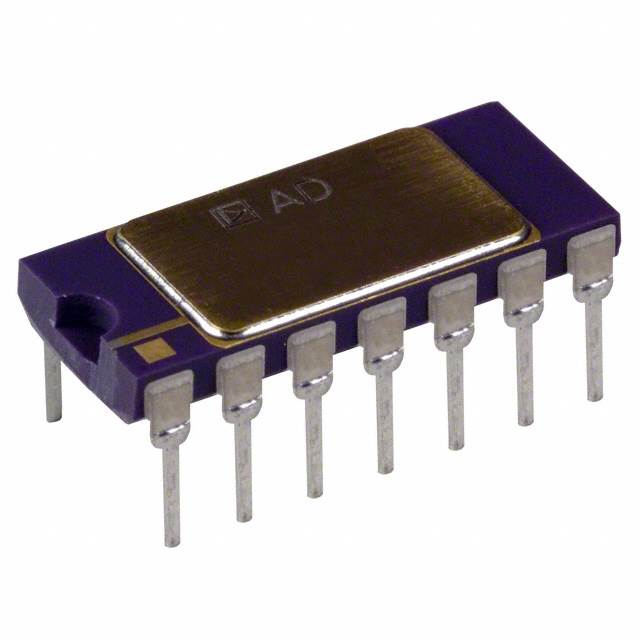Veja as especificações para detalhes do produto.

AD650BD
Product Overview
Category
The AD650BD belongs to the category of analog devices, specifically in the field of voltage-to-frequency converters.
Use
It is used for converting an analog input voltage into a proportional frequency output.
Characteristics
- High precision
- Wide operating voltage range
- Low power consumption
- Compact size
Package
The AD650BD comes in a standard 14-pin dual in-line package (DIP).
Essence
The essence of the AD650BD lies in its ability to accurately convert analog voltages to frequency signals, making it suitable for various applications in instrumentation and control systems.
Packaging/Quantity
The AD650BD is typically packaged in tubes or trays and is available in varying quantities based on customer requirements.
Specifications
- Input Voltage Range: ±10V
- Frequency Output Range: 0Hz to 1MHz
- Operating Temperature Range: -40°C to +85°C
- Supply Voltage: ±5V to ±18V
- Power Consumption: 1.2mW
Detailed Pin Configuration
- VPOS: Positive supply voltage
- VIN: Analog input voltage
- GND: Ground
- FREQ OUT: Frequency output
- TRIM: Frequency trim
- COMP IN: Comparator input
- COMP OUT: Comparator output
- VNEG: Negative supply voltage
- OSC OUT: Oscillator output
- OSC IN: Oscillator input
- OSC GND: Oscillator ground
- OSC V+: Oscillator positive supply
- OSC V-: Oscillator negative supply
- NC: No connection
Functional Features
- Voltage-to-frequency conversion
- On-chip oscillator and comparator
- Frequency trim for calibration
- Wide operating voltage range
Advantages
- High precision and accuracy
- Versatile frequency output range
- Low power consumption
- Robust and reliable performance
Disadvantages
- Limited frequency resolution at lower input voltages
- Sensitivity to external noise and interference
Working Principles
The AD650BD operates on the principle of converting the input analog voltage into a corresponding frequency output using an internal oscillator and comparator. The input voltage is compared with an internal reference, and the resulting frequency output is directly proportional to the input voltage.
Detailed Application Field Plans
The AD650BD finds extensive application in: - Precision measurement instruments - Data acquisition systems - Industrial automation - Process control systems - Frequency synthesizers
Detailed and Complete Alternative Models
Some alternative models to the AD650BD include: - AD654: Voltage-to-frequency converter with similar specifications - LTC6948: High-frequency voltage-controlled oscillator - MAX038: Precision waveform generator IC
In conclusion, the AD650BD is a versatile and reliable voltage-to-frequency converter that offers high precision and wide applicability across various industries.
Word Count: 443
Liste 10 perguntas e respostas comuns relacionadas à aplicação de AD650BD em soluções técnicas
What is the AD650BD?
- The AD650BD is a versatile voltage-to-frequency converter that can be used in various technical solutions.
How does the AD650BD work?
- The AD650BD converts an input voltage into a proportional frequency output, making it suitable for applications such as frequency synthesis and signal conditioning.
What is the typical input voltage range for the AD650BD?
- The typical input voltage range for the AD650BD is ±10V, making it compatible with a wide range of input signals.
Can the AD650BD be used for frequency measurement?
- Yes, the AD650BD can be used for frequency measurement by converting the input voltage to a corresponding frequency output.
What are some common applications of the AD650BD?
- Common applications of the AD650BD include frequency synthesizers, function generators, and precision voltage-to-frequency conversion.
Is the AD650BD suitable for use in industrial control systems?
- Yes, the AD650BD is suitable for use in industrial control systems due to its accuracy and reliability.
Does the AD650BD require external components for operation?
- The AD650BD requires minimal external components for operation, making it relatively easy to integrate into technical solutions.
What is the frequency range of the output signal from the AD650BD?
- The frequency range of the output signal from the AD650BD is typically 0.001Hz to 1MHz, providing flexibility for various applications.
Can the AD650BD operate in harsh environmental conditions?
- The AD650BD is designed to operate in a wide temperature range and is suitable for use in harsh environmental conditions.
Is the AD650BD suitable for battery-powered applications?
- Yes, the AD650BD's low power consumption makes it suitable for battery-powered applications where energy efficiency is important.

